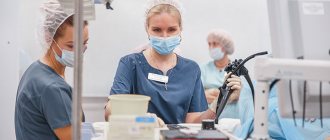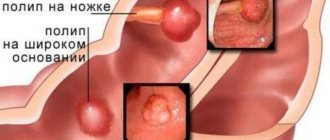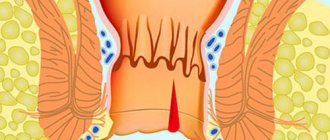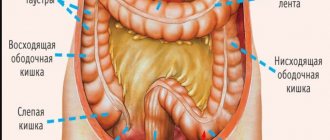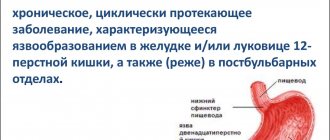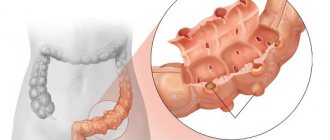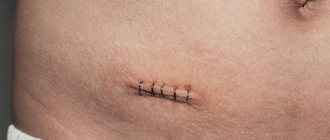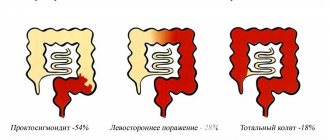Rectal fistulas occur in the chronic form of paraproctitis. During the course of the disease, a fistula canal is formed in the pararectal (peri-rectal) space, which has exits at both ends. The first - directly into the rectum, the second - onto the surface of the gluteal or perianal region or perineum.
The presence of fistula tracts causes significant disturbances in the body. Therefore, the pathology must be eliminated as early as possible.
If you suspect a disease, you can make an appointment at the Otradnoe Polyclinic, schedule a consultation with a doctor at a time convenient for you, undergo diagnostics and receive treatment that will allow you to avoid serious consequences.
Causes
In most cases, a rectal fistula is formed due to purulent inflammation of the perirectal tissue, and its appearance indicates an already present acute or chronic paraproctitis.
The reasons for the formation of a fistula are as follows:
- failure to consult a doctor in a timely manner if paraproctitis develops;
- incorrectly prescribed treatment;
- improper performance of an operation to remove an abscess, accompanied only by opening and draining the abscess without prescribing correctly selected antibiotic therapy.
Paraproctitis itself is most often provoked by mixed flora:
- coli;
- staphylococci;
- streptococci.
In more rare cases, purulent inflammation is caused by specific infectious agents such as tuberculosis, syphilis, chlamydia, actinomycosis or clostridia.
The state of immunity is also of no small importance in creating the prerequisites for the occurrence of paraproctitis and fistula. In many patients, acute or chronic paraproctitis occurs without the formation of a fistula in the rectum, but when there is a malfunction in the immune system, they form.
The following conditions can cause such violations of the human body’s defense system:
- specific infectious diseases;
- bowel problems: frequent constipation or diarrhea;
- acute and chronic intestinal infections;
- a history of intestinal diseases: enteritis, Crohn's disease, hemorrhoids, anal fissures, papillitis, proctitis, cryptitis, intestinal cancer and ulcerative colitis.
Classification
Rectal fistulas are divided into several types. They can be complete, incomplete and internal.
Complete fistulas always have two openings - an internal one, located in the anal crypt and opening into the intestinal lumen, and an external one on the surface of the skin, most often near the anus.
An incomplete fistula is characterized by the presence of only an internal opening on the surface of the mucosa. Most authors argue that an incomplete fistula is a temporary phenomenon, just a stage in the formation of a complete fistula, since sooner or later the surrounding tissue melts and the fistula tract breaks out.
With internal fistulas, both openings, the entrance and exit, are located in the wall of the rectum.
Based on the location of the fistula tract relative to the external rectal sphincter, fistulas are divided into intrasphincteric, extrasphincteric and transsphincteric.
Intrasphincteric, or subcutaneous-submucosal, or marginal fistulas are the simplest type of rectal fistula. They usually have a straight fistulous tract without scars and open with an external opening near the anus. The internal opening of such a fistula is located on the surface of the intestinal crypt.
The course of the transsphincteric fistula occurs at different depths through the external sphincter of the rectum. This type of fistula has one peculiarity: the higher the passage lies in relation to the sphincter, the more it branches, the more often purulent streaks form in the perirectal tissue, and scar tissue forms around the fistula. Scars can also affect the sphincter itself, leading to its deformation and dysfunction.
The third type of rectal fistula, extrasphincteric fistula, is distinguished by the fact that its internal opening is located on the surface of the intestinal crypt, and the course itself goes quite high, without touching, but going around the external sphincter. Such fistulas are usually formed when a purulent focus is localized in the pelvic-rectal, ileal-rectal and retrorectal tissue spaces, and their frequency is 15–20% of the total number of cases of the disease.
Extrasphincteric fistulas are characterized by tortuosity and a fairly long course, the formation of purulent streaks and the formation of scars around the fistula canal, as well as the appearance of new external openings with repeated exacerbations of the process. It is also possible for inflammation to transfer to the cellular space of the opposite side with the formation of a horseshoe-shaped fistula.
The presence of purulent streaks and scars along the extrasphincteric fistula is important for the choice of surgical method in the treatment of such a fistula. In this regard, there is a classification that distinguishes 4 degrees of complexity of extrasphincteric fistulas:
- I degree - there are no scars around the narrow internal opening, the course of the fistula is straight, there are no purulent streaks or infiltrates in the perirectal tissue
- II degree - scars appear around the internal opening, but there are no infiltrates or ulcers in the tissue
- III degree – the entrance to the fistula canal is narrow, without scars, there are inflammatory infiltrates and ulcers in the tissue
- IV degree – the inlet is wide, there are multiple scars around it, there are infiltrates and ulcers in the perirectal tissue
It doesn’t really matter where the rectal fistula is located - the symptoms of the disease are similar in its different forms.
Excision of a fistula without using a scalpel
Modern medicine can offer an atraumatic method of excision of rectal fistulas using a laser. It is considered non-surgical, but is suitable for people with simple complete fistulas that do not have swelling with curvature.
Laser excision
The laser method has a number of advantages:
- no pain,
- almost complete absence of blood,
- no complications,
- minimizing the likelihood of relapses,
- speedy recovery.
As for contraindications, there are practically no contraindications for laser excision of fistulas, which makes the method a priority.
Symptoms of rectal fistula
With a rectal fistula, the patient notices on the skin of the perianal area the presence of a wound - a fistula tract, from which ichor and pus are periodically released, staining the linen. In this regard, the patient is forced to frequently change pads, wash the perineum, and do sitz baths. Copious discharge from the fistula tract causes itching, maceration and irritation of the skin, accompanied by a foul odor.
If the rectal fistula is well drained, the pain syndrome is mild; severe pain usually occurs with an incomplete internal fistula due to chronic inflammation in the thickness of the sphincter. Increased pain is observed at the time of defecation, when a fecal bolus passes through the rectum; after sitting for a long time, when walking and coughing.
Rectal fistulas have a wave-like course. Exacerbation occurs when the fistula tract is blocked by granulation tissue and purulent-necrotic mass. This can lead to the formation of an abscess, after spontaneous opening of which the acute phenomena subside: the discharge from the wound and pain decrease. However, complete healing of the external opening of the fistula does not occur and after some time the acute symptoms resume.
During the period of remission, the patient’s general condition does not change, and with careful hygiene, the quality of life does not suffer much. However, a long course of rectal fistula and constant exacerbations of the disease can lead to asthenia, poor sleep, headache, periodic fever, decreased ability to work, nervousness, and decreased potency.
Complex rectal fistulas that exist for a long time are often accompanied by severe local changes - deformation of the anal canal, cicatricial muscle changes and insufficiency of the anal sphincter. Often, as a result of rectal fistula, pectenosis develops - scarring of the walls of the anal canal, leading to its stricture.
Subcutaneous form
The subcutaneous form is the most common, accounting for more than 50% of cases. Its main symptoms are acute pain that worsens during bowel movements or movement. Body temperature usually rises to 39 degrees and is accompanied by chills. During a diagnostic examination, the patient is found to have hyperemia, deformation of the anal canal, and swelling. When palpated, the pain around the anus only intensifies. Therefore, during palpation it is advisable to use anesthesia, since this will make it possible to more accurately determine the size of the infiltrate, and then make the right decision about its elimination.
Diagnostics
In the vast majority of cases, determining the diagnosis does not involve any difficulties. In particular, in this matter they start from the patient’s complaints, visual examination of the corresponding area for the presence of fistulous tracts, palpation (rectal examination, in which a digital examination of the rectum is performed with the subsequent identification of a fistulous tract, defined in this process as a “failure” on the part of the intestinal walls).
A study is also carried out using a special probe, which clarifies the direction of the fistula, as well as the area in which the entrance hole is located within the mucous wall of the rectum. In any case, tests are carried out using dyes, due to which it is possible to determine the specific type of fistula (complete, incomplete fistula). The sigmoidoscopy method makes it possible to identify the inflammatory process in the mucous membrane of the intestinal wall, as well as the relevance of accompanying tumor formations, hemorrhoidal fissures and nodes, which are considered as predisposing factors for the formation of fistulas.
Women are required to undergo a gynecological examination aimed at excluding vaginal fistula.
Folk remedies
You can reduce symptoms before excision of a rectal fistula and speed up healing afterwards using traditional home medicine. This includes douching with herbal infusions or using baths. Decoctions are prepared with:
- medicinal chamomile,
- yarrow,
- St. John's wort,
- calendula.
Baths for the treatment of rectal fistula
You can use one plant or in combination. 15-minute baths with sea salt (lightly salted solution) are effective. Ointments made from flaxseed, peppermint and oak bark are relevant when using lard as a base. To increase immunity, it is allowed to use products with honey or other bee products, Echinacea purpurea, ginseng, marshmallow and similar herbs.
Features of treatment
Many people wonder whether it is possible to treat rectal fistula without surgery? It is necessary to start with the fact that no actions should be carried out without first consulting the attending physician. It is he who can and should determine the final restoration tactics. Most often, a specialist prescribes antibiotic therapy, the use of painkillers and local healing drugs.
It is strongly recommended to pay attention to the following:
- similar measures are taken to alleviate the patient’s condition;
- physiotherapeutic procedures can be prescribed in preparation for surgery;
- this is necessary to reduce the risk of complications after surgery aimed at removing a perirectal fistula and any other;
- It is not recommended to use folk remedies for such a diagnosis, because they are not able to remove the fistula or at least stop its subsequent development - this is evidenced by numerous reviews.
The leading method of treating fistulas should be considered surgical. Removal or excision of the rectal fistula is the only radical treatment. After the onset of remission, performing a surgical operation is irrational, since at this stage the doctor will not see clear guidelines along which it is necessary to excise tissue.
- Planned interventions can be performed when an abscess appears - an abscess of the rectum. To do this, the surgeon opens it and drains it.
- Next, the patient is prescribed massive antibiotic therapy aimed at eliminating the causative agent of the disease. The choice of drugs depends on the cause of the formation of the fistula, and antibiotics are administered not only orally and parenterally, but also in the form of solutions for washing the drainage system created during the operation.
- To accelerate the onset of the required therapeutic effect and in the absence of contraindications, the patient is prescribed physiotherapy (Ultraviral irradiation and electrophoresis).
After eliminating all acute inflammatory processes, the patient undergoes the following operation. To remove a fistula, various types of surgical interventions can be performed, aimed at dissection or complete excision of the tissues of the fistula tract. If necessary, during the operation the doctor may perform:
- sphincter suturing;
- drainage of purulent pockets;
- displacement of the muscular-mucosal or mucous tissue flap to completely close the formed internal course of the rectal fistula.
The choice of intervention method depends on the clinical case. Often, the full extent of the operation becomes known after it has begun, that is, after the surgeon can visually assess the location of the fistula, the presence of compactions and purulent leaks, and the severity of scar lesions in the pararectal area.
Next, I would like to draw attention to what exactly will need to be done in order to recover from any type of surgical intervention.
Pathological physiology
Pathological changes in the body are determined primarily by the localization and complications of K. s. The higher the fistula is located, the greater its negative effect on the body. In this case, complete fistulas or incomplete ones, but with significant discharge, quickly lead to pronounced disorders in the body. The release of large amounts of fluid, enzymes, electrolytes and undigested foods leads to progressive depletion of the body. The greatest changes, consisting of progressive dystrophy, are observed in the liver and kidneys.
With external K., especially in the small intestine, hypoproteinemia with disproteinemia occurs quite quickly, manifested by hypoalbuminemia, an increase in alpha and gamma globulin fractions. Depending on the height of the fistula, the water-electrolyte balance is disturbed to one degree or another; hypokalemia and hypovolemia occur especially quickly, which, in turn, contribute to electrolyte imbalance. These changes are less pronounced in low intestinal fistulas and colonic fistulas. However, when purulent-septic complications are added to the latter, toxemia phenomena develop, which also lead to severe degenerative changes with the development of hepatic-renal failure.
The cause of death in K. s. Most authors consider the loss of digestive juices, electrolytes, a sharp disturbance of protein metabolism, and dehydration of the body.
Features of the postoperative period: diet
Usually, within a few hours after surgery, the patient is allowed to drink fluids. As you recover from anesthesia, discomfort and quite intense pain may occur. Therefore, during the first three days the patient is prescribed painkillers.
A bandage is applied to the site of the surgical wound, a gas outlet tube and a hemostatic sponge are inserted into the anus. They are removed one day after surgery during the first dressing. Dressings are quite painful; to facilitate the procedure, the patient is prescribed treatment with local anesthetics (ointments, gels). During this period, the doctor must carefully monitor the healing process; it is important that the edges of the wound do not stick together and that undrained pockets do not form in it.
If complex fistulas were removed, then a week after the operation a dressing will be required under anesthesia. During it, a deep revision of the wound is made and the ligature is tightened. To quickly heal the wound and reduce discomfort, the doctor may prescribe sitz baths with chamomile decoction or a weak solution of potassium permanganate.
In the first two days after the operation, the patient is prescribed a special liquid diet (kefir, water, a little boiled rice). This is done so that the patient does not have a bowel movement for several days after surgery. In the absence of stool, the postoperative wound will not become infected with feces, and the healing process will go faster.
In the postoperative period, it is important for the patient to follow a proper and balanced diet; meals should be divided, eating in small portions 5-6 times a day. Fatty, fried, spicy, pickled foods, smoked foods, spices, and carbonated water are excluded from the diet. You should give preference to foods high in fiber (vegetables, fruits), include porridge, grain bread, fermented milk products in your menu and drink more liquid.
This will help achieve soft stools and improve bowel function. Avoid constipation and take laxatives if necessary. After discharge from the hospital, the patient needs to be especially attentive to his own well-being and immediately consult a doctor if the following symptoms occur:
- A sharp increase in temperature.
- Constant pain in the abdominal area.
- Fecal incontinence, excessive gas formation.
- Painful bowel movements or urination.
- The appearance of purulent or bloody discharge from the anus.
These manifestations indicate the development of complications; it is necessary not to delay contacting a specialist and not to self-medicate. If there are no complications, the patient can return to normal life after two to three weeks. Complete recovery and wound healing occurs six weeks after surgery.
When discharged from the hospital, be sure to discuss with your doctor when to come for a follow-up examination.
Reviews
Svetlana K. 35 years old:
The fistula was formed as a result of paraproctitis. First, something like a boil appeared on the skin, which opened on its own. But no matter what I applied, the wound did not heal, pus and ichor constantly came out. For a long time I was embarrassed to go to the doctor, but when the pus just started pouring out constantly, I finally decided. We discovered a rectal fistula - a very unpleasant and painful condition. When the operation was performed, I could neither sit nor stand for a week. But I was successfully cured and now, I hope, this will not happen again. There was only a small mark left on the skin from the stitches.
Gennady R. 49 years old:
I underwent excision of the fistula into the lumen of the rectum under general anesthesia. I was in the hospital for 7 days, and when the stitches were removed, I went home with detailed doctor’s recommendations. But, to be honest, I didn’t follow all the recommendations; I decided that the wound had already healed and there was no need to worry. After some time, I began to notice that there was purulent discharge in the stool, similar to what was present before the operation. I immediately ran to the doctor, and on time - I managed to avoid a relapse. I was treated with antibiotics, suppositories, diet, and everything returned to normal, so remember that the postoperative period is very important in the recovery process and be sure to follow the recommendations.
Possible complications
Over a long period of time, rectal fistula can cause:
- In some cases, inflammatory and necrotic processes occurring in the pararectal area cause the proliferation of connective tissue (i.e., scarring) and narrowing of the anal canal.
- Deformation of the anal sphincter and changes in the condition of the muscles surrounding this anatomical area. As a result, the patient develops rectal sphincter insufficiency.
- The most severe complication of rectal fistula can be a cancerous tumor of this part of the intestine.
Clinical picture
The main symptom of external intestinal fistula is the release of chyme, gases or feces from the wound. With low fistulas, especially the left half of the colon, the discharge is periodic. The severity of the clinical picture is determined by the location of the fistula, the amount of excreta released from it, as well as the presence of complications. Complications of K. s. occur in the form of dermatitis, skin maceration, formation of purulent cavities, phlegmon of subcutaneous and retroperitoneal tissue, osteomyelitis. The most severe complication is septicopyemia and septicemia (see Sepsis).
Prevention
To prevent fistulas and paraproctitis, the following is necessary:
- consume various spicy foods, sauces, and alcohol in moderation;
- avoid canned foods;
- prevent constipation;
- avoid overexertion.
To prevent constipation, you need to consume one and a half to two tablespoons of ground bran daily. Also include in your diet more foods rich in dietary fiber - fruits, vegetables, oatmeal, and drink at least 2 liters of water.
Which doctor should I contact?
If you experience pain in the anus and discharge of a purulent or sanguineous nature, you should consult a proctologist.
After examining and interviewing the patient to clarify the diagnosis, the doctor will prescribe a series of laboratory and instrumental studies; probing of the fistula tract with contrast tests, anoscopy, sigmoidoscopy, ultrasound, CT, etc.
If tuberculosis or syphilis is suspected, the patient needs consultation with a phthisiatrician or venereologist.
Paraproctitis Rectal cancer Proctitis Crohn's disease Hemorrhoids Hiatal hernia
General characteristics of the pathology
A fistula is also called a fistula tract. It is a pathologically formed canal that extends from the intestine and ends in the fatty tissue that surrounds it, or on the skin of the buttocks. Normally there is no such channel.
Fistula is a chronic pathology, since the duration of its persistence is six months or more. Its characteristic wave-like course implies the presence of remissions, which are periodically replaced by exacerbations. As these periods subside, the signs of the disease decrease or disappear completely.
The formation of a fistula is considered a chronic form of paraproctitis. It is also considered a complication of this disease. The pathological process affects the fatty tissue that surrounds the rectum.
